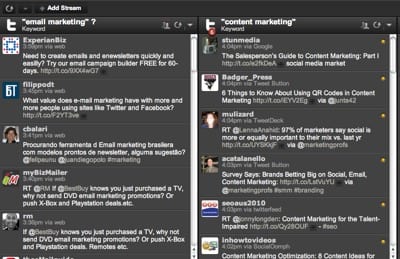Before we start. Why do you use Twitter? No, not that reason. Why do you ‘really’ use Twitter?
Let’s be honest, if Twitter didn’t allow us to grow our business, find leads, make connections… and improve our bank balance, we wouldn’t use it as much, would we?
Once we agree on this, we can start to look at Twitter through a different lens. Rather than seeing it as a place to pass the time, it becomes an instrument to network more effectively. What’s wrong with that 🙂
When we start using Twitter – or wonder if we’re using it correctly – a few things emerge:
- Am I getting the returns I expected?
- Have I found the leads I need?
- Is it raising my profile?
- Does engagement lead to conversions? And, if not, why?
There’s a lot of ground to cover here but let’s look at how one can achieve some of these goals.
1. Following people doesn’t work because
When you start using Twitter, it’s like entering a massive cocktail party. Lots of noise, lots of people and a bit overwhelming. Maybe you try to follow what’s going on for a while and then stop.
Watching 20 tweets refresh on your screen every minute drives anyone to distraction. Maybe there’s a better way.
2. Copying experts doesn’t work because…
Why not learn how the experts do it and copy their style?
This is a step in the right direction for sure as you’ll learn more structured ways to leverage Twitter but… it’s not as effective for them as it is for you. Why?
Because they’re starting from a different place than you. They have an offline community, connections in the industry, and influence you’ll never have.
And they may have funds to promote their profile (and buy products) that are out of your range. Who knows, they may not even write their tweets, which is another story…
3. Following lists doesn’t work because…
I asked Chris Brogan how he managed to follow 80k people and he made two points.
Develop ears (e.g. setup Google alerts to ‘hear’ where you get mentioned) and create/follow lists.
This works up to a point. I have a (private, not public) Twitter lists for those who’ve helped me and share quality information. I keep it at around 100 and prune every month.
However, this list (while fine in other ways) doesn’t generate many leads. Some yes, but not many.
Why?
They’re not customers. Most are friends I engage with and try to help when I can. They’re my inner circle. Some I do JVs with but you get the idea.
4. Following lists works if…
you create lists around what you’re selling. Let’s be specific. If you’re selling online education products for children (great area, btw), create your own list of people who are influential in this area.
- Connect with them.
- Share tweets.
- DM to introduce yourself and…
Follow them to their website, Facebook and LinkedIn and continue to engage there.
Why?
Twitter is a discovery platform that allows you to connect more effectually.
Don’t look at Twitter in isolation. Integrate it into your overall social media action plan and sync it with other activities. Build bridges otherwise you’ll have social media islands.
Once you see it in these terms, adapt how you use it.
5. Finding problems works best because…
The next logical step is to find problems in this area, e.g. what subjects should parents teach their children, what tools should they use, what risks are involved, how much should they pay and so on?
You can do this on Twitter . Type in
‘education software’ ?
This returns all tweets for the exact match education software (not education and software) and… questions related to this area.
Note: Appending the ? to the query does the trick!
Next, save the search in a column (I use Hootsuite to do this) and respond to as many queries as possible.
By doing this, you can respond to queries almost immediately, send customers to your sales page, or other third party sites that resolve their issue.
Use different variations of this to find leads, position yourself as an authority and… justify the time you spend on Twitter.
Compared to following people – who rarely reciprocate, anyway – it’s a no brainer.
Takeaway
Don’t throw the baby out with the bathwater! Lists, topics, and chats are all fine if… they help you achieve your goals. Which you have to define first, of course.
Following topics and queries allows you to meet people with immediate, pressing needs.
If you can respond to a small percentage of them, you’re likely to get consultancy work, signups or affiliate sales.
That’s just me. How do you use Twitter? What’s the most effective way to use it to generate sales?


